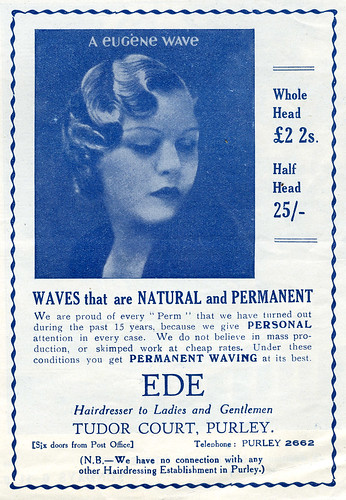
Advertisement from the Davis Standard (a Croydon cinema newsheet), November-December 1933. Eugène permanent wave, originally uploaded by Trevira.
You could perm your 'whole head' at Ede, hairdresser to the ladies and gentlemen of Purley. Or half your head for 25 shillings, if you were a bit strapped for cash.
You could perm your 'whole head' at Ede, hairdresser to the ladies and gentlemen of Purley. Or half your head for 25 shillings, if you were a bit strapped for cash.
£2 2s in 1933 would be equivalent to £111.09 these days, according to the handy calculator on measuringworth and using the Retail Price Index alone. This was a considerable sum to invest in a process that might last a couple of months before it grew out.
Ede of Purley favoured the Eugène system of permanent waving, developed by the Swiss Eugene Suter and his Spanish technical whizz Isidoro Calvete in London in 1917. There's some marvellously alarming photographs of their perming machines in the Wikipedia entry on the Perm (hairstyle), including this example from 1923:

Ede of Purley favoured the Eugène system of permanent waving, developed by the Swiss Eugene Suter and his Spanish technical whizz Isidoro Calvete in London in 1917. There's some marvellously alarming photographs of their perming machines in the Wikipedia entry on the Perm (hairstyle), including this example from 1923:

Photograph from Louis Calvete, son of Isidoro Calvete, used under CC license.
It might look terrifying, but it must have worked, and indeed worked very well. So well that Eugene's name became "synonymous with permanent waving throughout the world," and you don't achieve that by electrocuting your clients!
And this little film from 1935, courtesy of British Pathé, shows a later system which used heated clamps allowing the permee [??] to wander about rather than being tethered by the hair to an electrical contraption:






2 comments:
Sweetie Sarah! You have the coolest info!!!! Now I know what "my look" is missing...A PERM!!! Thanks for sharing that wonderful MeasuringWorth website. Have added it to my favs!
:)
Cheers fauxbrit13!
Its a tricky one trying to work out how much something from the past would cost today. On measuringworth they have a number of parameters, and I picked the Retail Price Index because that's the one they recommend for discovering the 'present worth' of commodities.
Its certainly more helpful than saying, for example, that 2 shillings is equal to 10 pence today! That's just giving the equivalent currency rather than an idea of its value.
Gosh, I'm such a history nerd!
Post a Comment